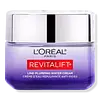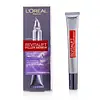What's inside
What's inside
 Key Ingredients
Key Ingredients

 Benefits
Benefits

 Concerns
Concerns

 Ingredients Side-by-side
Ingredients Side-by-side

Water
Skin ConditioningPropylene Glycol
HumectantGlycerin
HumectantDimethicone
EmollientAlcohol Denat.
AntimicrobialOctyldodecanol
EmollientCaprylyl Methicone
Skin ConditioningBetaine
HumectantNiacinamide
SmoothingIsohexadecane
EmollientHydroxypalmitoyl Sphinganine
Skin ConditioningSodium Acetylated Hyaluronate
HumectantSodium Hyaluronate
HumectantSodium Hydroxide
Buffering2-Oleamido-1,3-Octadecanediol
Skin ConditioningTocopheryl Acetate
AntioxidantCeramide NP
Skin ConditioningHydrogenated Lecithin
EmulsifyingAcrylates/C10-30 Alkyl Acrylate Crosspolymer
Emulsion StabilisingCarbomer
Emulsion StabilisingXanthan Gum
EmulsifyingDimethiconol
EmollientChlorphenesin
AntimicrobialPhenoxyethanol
PreservativeWater, Propylene Glycol, Glycerin, Dimethicone, Alcohol Denat., Octyldodecanol, Caprylyl Methicone, Betaine, Niacinamide, Isohexadecane, Hydroxypalmitoyl Sphinganine, Sodium Acetylated Hyaluronate, Sodium Hyaluronate, Sodium Hydroxide, 2-Oleamido-1,3-Octadecanediol, Tocopheryl Acetate, Ceramide NP, Hydrogenated Lecithin, Acrylates/C10-30 Alkyl Acrylate Crosspolymer, Carbomer, Xanthan Gum, Dimethiconol, Chlorphenesin, Phenoxyethanol
Water
Skin ConditioningGlycerin
HumectantDimethicone
EmollientSaccharomyces/Xylinum/Black Tea Ferment
Skin ConditioningPropanediol
SolventDiisopropyl Sebacate
EmollientPentylene Glycol
Skin ConditioningBetaine
HumectantDi-C12-13 Alkyl Malate
EmollientButyrospermum Parkii Butter
Skin ConditioningPolyglyceryl-6 Distearate
EmulsifyingHydroxypropyl Tetrahydropyrantriol
Skin ConditioningCetyl Alcohol
EmollientMyristyl Myristate
EmollientPentaerythrityl Tetraethylhexanoate
EmollientPropylene Glycol
HumectantAmmonium Acryloyldimethyltaurate/Steareth-25 Methacrylate Crosspolymer
Emulsion StabilisingJojoba Esters
EmollientSodium Hyaluronate
HumectantStearalkonium Hectorite
Gel FormingBehenyl Alcohol
EmollientDisodium Stearoyl Glutamate
CleansingDimethicone/Vinyl Dimethicone Crosspolymer
Skin ConditioningPhenoxyethanol
PreservativeCaprylyl Glycol
EmollientXanthan Gum
EmulsifyingPolyglyceryl-3 Beeswax
EmulsifyingDimethiconol
EmollientCaffeine
Skin ConditioningAscorbyl Glucoside
AntioxidantChlorphenesin
AntimicrobialDisodium EDTA
Hydroxyethylcellulose
Emulsion StabilisingTocopheryl Acetate
AntioxidantSodium Citrate
BufferingCitric Acid
BufferingSecale Cereale Seed Extract
AbrasivePotassium Sorbate
PreservativeBiotin
AntiseborrhoeicDipeptide Diaminobutyroyl Benzylamide Diacetate
Skin ConditioningWater, Glycerin, Dimethicone, Saccharomyces/Xylinum/Black Tea Ferment, Propanediol, Diisopropyl Sebacate, Pentylene Glycol, Betaine, Di-C12-13 Alkyl Malate, Butyrospermum Parkii Butter, Polyglyceryl-6 Distearate, Hydroxypropyl Tetrahydropyrantriol, Cetyl Alcohol, Myristyl Myristate, Pentaerythrityl Tetraethylhexanoate, Propylene Glycol, Ammonium Acryloyldimethyltaurate/Steareth-25 Methacrylate Crosspolymer, Jojoba Esters, Sodium Hyaluronate, Stearalkonium Hectorite, Behenyl Alcohol, Disodium Stearoyl Glutamate, Dimethicone/Vinyl Dimethicone Crosspolymer, Phenoxyethanol, Caprylyl Glycol, Xanthan Gum, Polyglyceryl-3 Beeswax, Dimethiconol, Caffeine, Ascorbyl Glucoside, Chlorphenesin, Disodium EDTA, Hydroxyethylcellulose, Tocopheryl Acetate, Sodium Citrate, Citric Acid, Secale Cereale Seed Extract, Potassium Sorbate, Biotin, Dipeptide Diaminobutyroyl Benzylamide Diacetate
 Reviews
Reviews

Ingredients Explained
These ingredients are found in both products.
Ingredients higher up in an ingredient list are typically present in a larger amount.
Betaine is a common humectant (a substance that promotes retention of moisture). It's known to be gentle on the skin and can help balance hydration.
This ingredient is best for improving hydration and soothing irritated skin. Studies also show it helps even out skin tone.
Fun fact: Betaine is naturally created in the skin and body. The kind found within cosmetic products can be either plant-derived or synthetic.
Another name for betaine is trimethylglycine.
Learn more about BetaineChlorphenesin is a synthetic preservative. It helps protect a product against bacteria in order to extend shelf life. In most cases, Chlorphenesin is paired with other preservatives such as phenoxyethanol and caprylyl glycol.
Chlorphenesin is a biocide. This means it is able to help fight the microorganisms on our skin. It is also able to fight odor-releasing bacteria.
Chlorphenesin is soluble in both water and glycerin.
Studies show Chlorphenesin is easily absorbed by our skin. You should speak with a skincare professional if you have concerns about using Chlorphenesin.
Learn more about ChlorphenesinDimethicone is a type of synthetic silicone created from natural materials such as quartz.
What it does:
Dimethicone comes in different viscosities:
Depending on the viscosity, dimethicone has different properties.
Ingredients lists don't always show which type is used, so we recommend reaching out to the brand if you have questions about the viscosity.
This ingredient is unlikely to cause irritation because it does not get absorbed into skin. However, people with silicone allergies should be careful about using this ingredient.
Note: Dimethicone may contribute to pilling. This is because it is not oil or water soluble, so pilling may occur when layered with products. When mixed with heavy oils in a formula, the outcome is also quite greasy.
Learn more about DimethiconeDimethiconol is a silicone that resembles the popular dimethicone. Like other silicones, it is an emollient. Emollients create a thin film on skin to prevent moisture from escaping.
This ingredient helps to create a silky texture and improve spreadability. Due to its high molecular weight and thickness, it is often combined with cyclopentasiloxane.
Glycerin is already naturally found in your skin. It helps moisturize and protect your skin.
A study from 2016 found glycerin to be more effective as a humectant than AHAs and hyaluronic acid.
As a humectant, it helps the skin stay hydrated by pulling moisture to your skin. The low molecular weight of glycerin allows it to pull moisture into the deeper layers of your skin.
Hydrated skin improves your skin barrier; Your skin barrier helps protect against irritants and bacteria.
Glycerin has also been found to have antimicrobial and antiviral properties. Due to these properties, glycerin is often used in wound and burn treatments.
In cosmetics, glycerin is usually derived from plants such as soybean or palm. However, it can also be sourced from animals, such as tallow or animal fat.
This ingredient is organic, colorless, odorless, and non-toxic.
Glycerin is the name for this ingredient in American English. British English uses Glycerol/Glycerine.
Learn more about GlycerinPhenoxyethanol is a preservative that has germicide, antimicrobial, and aromatic properties. Studies show that phenoxyethanol can prevent microbial growth. By itself, it has a scent that is similar to that of a rose.
It's often used in formulations along with Caprylyl Glycol to preserve the shelf life of products.
Propylene Glycol is an odorless, colorless liquid. As a humectant, it helps skin retain moisture. It also aids in delivering active ingredients.
Another role of this ingredient is preventing a product from melting or freezing. Propylene glycol also adds antimicrobrial properties to a product, elongating product lifespan.
This ingredient is considered an organic alcohol and commonly added into both cosmetics and foods.
Those with sensitive skin or conditions may develop a rash when using this ingredient.
Learn more about Propylene GlycolSodium Hyaluronate is hyaluronic acid's salt form. It is commonly derived from the sodium salt of hyaluronic acid.
Like hyaluronic acid, it is great at holding water and acts as a humectant. This makes it a great skin hydrating ingredient.
Sodium Hyaluronate is naturally occurring in our bodies and is mostly found in eye fluid and joints.
These are some other common types of Hyaluronic Acid:
Learn more about Sodium HyaluronateTocopheryl Acetate is AKA Vitamin E. It is an antioxidant and protects your skin from free radicals. Free radicals damage the skin by breaking down collagen.
One study found using Tocopheryl Acetate with Vitamin C decreased the number of sunburned cells.
Tocopheryl Acetate is commonly found in both skincare and dietary supplements.
Learn more about Tocopheryl AcetateWater. It's the most common cosmetic ingredient of all. You'll usually see it at the top of ingredient lists, meaning that it makes up the largest part of the product.
So why is it so popular? Water most often acts as a solvent - this means that it helps dissolve other ingredients into the formulation.
You'll also recognize water as that liquid we all need to stay alive. If you see this, drink a glass of water. Stay hydrated!
Learn more about WaterXanthan gum is used as a stabilizer and thickener within cosmetic products. It helps give products a sticky, thick feeling - preventing them from being too runny.
On the technical side of things, xanthan gum is a polysaccharide - a combination consisting of multiple sugar molecules bonded together.
Xanthan gum is a pretty common and great ingredient. It is a natural, non-toxic, non-irritating ingredient that is also commonly used in food products.
Learn more about Xanthan Gum